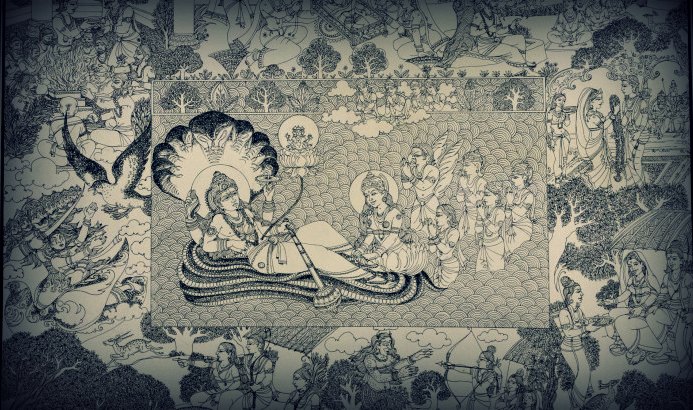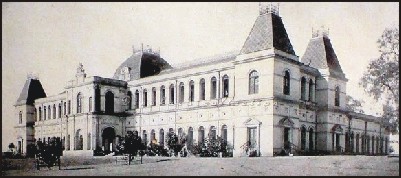The best biography of Professor Mysore Hiriyanna was written by Professor Mysore Hiriyanna himself not by using a paper and pen but by living life as he did. And that living revealed itself in every single sphere—in his personality, dressing, speech, conduct, values, teaching, and to the world as it knew him, in his writing.
Here are a few samples of his writing.
On Indian education, he holds that the “true aim of Indian Education is not to inform the mind but to form it.”
On Sva-Dharma (Self-Duty), he avers that the “performance of one’s own duties implies the abolition of all distinctions of high and low among them for, when we consider duties as means to renunciation, it is not their content that matter, but the selfless spirit in which they are done. All can therefore be sanyasins in this sense.”
On the distinction between acquiring an intellectual knowledge of philosophy and its practical application, he says: “it is not enough to think and know; one must also feel and experience. The knowledge conveyed by the teaching should be transformed into an immediate conviction.”
And on life and death: “Nature cares little for individual life, though life itself is precious to her; life preys upon life.”
The entire compendium of Hiriyanna’s work reflects, to borrow his own phrase, his continuous quest after perfection. Terse. Precise. Lucid. Perhaps very few writers on complex Indian philosophical concepts have managed to encompass so much using so few words.
And his writing attained this quality because philosophy to him was lived, as he says, as an “immediate conviction,” and not merely understood. To get a sense of this, we can quote N. Sivarama Sastry[i]:
He was a philosopher in the true Indian tradition to whom philosophy is was not only true thinking but also right living...He would not proceed against a man who cheated him. He would not even answer an unfair criticism. He would simply ignore it. His conviction was that untruth would destroy itself.
And further says that Hiriyanna modelled his life after Kalidasa’s ideal of his favourite deity Shiva, best exemplified by this verse of Raghuvamsha, which paints Dilipa’s character thus:
जुगोपात्मानमत्रस्तः भेजे धर्ममनातुरः।
अगृध्नुराददे सोऽर्थमसक्तः सुखमन्वभूत्॥ [1-21]
Dilipa conserved his body not out of anxiety, but to perform dutiful deeds; even if he was stricken with ill-health he performed dutiful deeds for duty's sake; he recouped wealth without avarice, and he enjoyed physical comforts without succumbing to temptation.
Indeed, Hiriyanna’s commitment to his lifelong vocation as a teacher resulted in producing legions of extraordinarily talented scholars. I shall list just three of the most accomplished ones: Dr. K. Krishnamurthy, Dr. T.N. Srikantaiah, and Devudu Narasimha Sastri.
When we also consider that fact that his writings shone with brilliance after being subject to rigorous examination in an age teeming with luminaries such as P.V. Kane, Ganganath Jha, Radha Kumud Mookherji, Surendranath Dasgupta, S. Radhakrishnan, and Suniti Kumar Chatterji, we have an even fuller picture of the exact nature of his abilities.
Wet Light
आर्द्रं ज्वलति ज्योतिरहमस्मि | ज्योतिर्ज्वलति ब्रह्माहमस्मि |
य़ोहमस्मि ब्रह्माहमस्मि | अहमेवा अहं मां जुहोमि स्वाहा ||
The self-effulgent waters shine. Fire is effulgent. I am that self-luminous One. I am Brahman. I (who is one such), am having Brahman as my Self. Being in that form as I am, I offer myself as oblation unto the Lord.
This celebrated verse from the Maharnarayana Upanishad apart from touching the pinnacle of pure philosophy is notable for the use of the words “Aardram” and “Jyoti,” a usage whose full connotation is impossible to couch definitively in English. At best it can be translated as “wet light.”
And this term, “Aardra Jyoti,” most fittingly, forms the title of Shatavadhani Dr. Ganesh’s short Kannada biography of Prof M. Hiriyanna, published a few years ago. As it stands, it is perhaps the only volume on this scholar-philosopher giant offering significant details about his life and work.
Decades before Aardra Jyothi was written, the most celebrated work about M. Hiriyanna’s life, personality and work is a brief profile-sketch in Kannada written by the legendary D.V. Gundappa (DVG) who was both his younger contemporary and long-time friend. Appearing in a volume titled Hrudaya Sampannaru in his multi-volumed Jnapaka Chitrashaale. DVG titled the essay as Hiriyannanavara Parishudda Panditya, literally meaning “M. Hiriyanna’s Chaste Scholarship.” It continues to remain a classic.
The following is my abridged translation of this profile of DVG.
Sandeep Balakrishna
I had been impressed just by listening to people’s accounts of the eminence of Professor M. Hiriyanna long before I had the fortune of meeting him in person. An ordinary schoolteacher was among my many gurus. He had been a student in the Mysore Teacher’s Training College where Hiriyanna was at the time serving as its President. This schoolteacher was well-versed Sanskrit, and I was taking Sanskrit grammar lessons from him. He used to repeatedly speak in glowing terms about Hiriyanna’s integrity and work ethic. That set me on a quest to meet this great soul and take his blessings.
I was finally conferred this great fortune in 1913-14.
The Training of a Vedantin
That year, the Shankar Mutt in Bangalore had organized a lecture by Hiriyanna as part of its annual Shankara Jayanti celebrations. The lecture was attended by a small crowd of less than hundred people. However, the stature of almost all the attendees was immense. It included greats like K.A. Krishnaswami Iyer, Belavadi Dasappa, Ramaswamayya, V. Subramhanya Iyer, Karpura Srinivas Rao, and K. Krishnappayya Iyengar. All of them enjoyed the lecture and praised it profusely.
I too, happened to be there. The lecture was titled “The Training of a Vedantin,” and I came away thoroughly impressed both by the manner of its delivery and the richness of its substance. And so I requested Hiriyanna to give me a copy of the lecture so that I could publish it in “The Karnataka,” the English biweekly that I was running in those days. The great man immediately agreed and gave me a handwritten copy of the lecture. That moment marked the beginning of my long association with him.
Hiriyanna was a high school teacher before he became the President of the Teacher’s Training College. He used to teach Mathematics, Geography and other subjects. After he came to the Teacher’s Training College, he wrote a few books in Kannada to help and guide students. One of them was titled “Smriti Shakti” (Brain/Memory Power), and another, “Bodhana Krama” (Method of Instruction). The names of these books may not be exact—I’ve quoted them from memory but I’ve definitely read the books. If I recall correctly, I think they first appeared in Bapu Subba Rao’s “Karnataka Granthamaale.” Later, they were printed as independent books. I’d be highly grateful if those of my esteemed readers, who have these books, can give them to me.
The Talent-spotting Abilities of H.V. Nanjundayya
Hiriyanna accepted the appointment in the Maharaja College as a Sanskrit lecturer after he quit the Teacher’s Training College. This appointment was one of the big successes of H.V. Nanjundayya, the first Vice Chancellor of the newly-formed Mysore University. Nanjundayya followed a really simple precept—he would identify the most eminent scholars of various branches of learning and would appoint them as the heads of the respective departments in the university. Thus, in a relatively short span, Mysore University was home to some of the finest minds of the time—of these, Sarvepalli Radhakrishnan, N.S. Subba Rao, C.R. Reddy, K.T. Shah, Radha Kumud Mookherjee, and R.Shama Sastri belonged to the highest order. Professor M.Hiriyanna stood shoulder to shoulder with these colossuses.
Hiriyanna was not a man of many words. He never rushed to the forefront aggressively. He didn’t lay claim to even those rights that came to him by virtue of his position. It is Nanjundayya’s greatness that he was able to unearth such a man and offer him a deservedly high position.
Sanskrit Study
Hiriyanna had learnt Sanskrit in the traditional way. His father lived in Shivarampet in Mysore. The three sons—M. Hiriyanna, M.N. Krishna Rao[ii], and N. Seetharamayya—were the direct disciples of the renowned Mysore Sanskrit scholar, Periswami Thirumalacharya who taught at the “Sadvidya Shala” school. The school taught Sanskrit in the traditional fashion, which included memorizing the entire Amarakosha[iii], and the dhaatupaata[iv]. After successfully completing this traditional schooling, they embarked on English education.
Hiriyanna’s scholarship reflected the enormous strength of this solid foundation of traditional learning. The manner in which he used to explain the origins and derivation of various words was a superb illustration of the thoroughness and integrity of his scholarship. I was not blessed with the fortune of learning from him, book in hand. However, I’ll narrate a personal experience, which I hope will shed some light on the method of his instruction.
Diligence of Instruction and Study
I had occasion to visit Mysore to attend a wedding at my younger brother’s house. Several of my scholar friends had also graced the function. However, Hiriyanna was not in attendance on the day of the wedding. He came the next day, in the afternoon.
Me: I was awaiting you yesterday. But that joy of meeting you is now mine.
Hiriyanna: I could’ve come yesterday but I don’t think we would have had time to talk—you would be busy attending to lots of relatives and guests. But I anticipated that you would be relatively freer today—so, here I am.
Me: In my community there is a ritual known as the “Neelalohita puja,” which is performed as part of the wedding ceremonies. What would you say is its intent and significance? The Bharatavakyam[v] of Kalidasa’s “Shakuntala,” has this verse—“kshapayatu neelalohita.” Is there a connection between that and this wedding ritual?
After this our conversation veered in various directions. Later, Hiriyanna stood up to take leave. I walked with him till his house in Lakshmipuram. There he gave me the notes he had made on the word “Neelalohita” when he was teaching Shakuntala [to his students in college]. These notes occupied two or three entire student notebooks. Beautiful handwriting. Neatly spaced out. The handwriting by itself was a visual treat. He had written out the explanations given by various scholars and commentators on the word “Neelalohita.” He had also written the corresponding sentences and usage of the word.
No Compulsion
Once I finished reading his notes, I asked him, “What could be the final conclusion?”
He replied, “I’ve placed before you all the material I could find on this word. It’s difficult for me to say anything conclusively.”
To this, I quoted some verses from the Rudra Suktam:
Namo astu neelagreevaaya|
Draape andhasaspate daridranneelalohita|
Hiriyanna said, “The Vedas could be the root of this usage.”
I said “we can synthesize this usage with sentences like this:
Neelagreevaasshitikantaahsharvaa adah kshamaacaraah|
Neelagreevaasshitikantaah divam rudraa upashritaah|
Meaning, the world is full of secrets wherever we look; there are things that we cannot explain thoroughly, and there are causes for fear everywhere we look. The word “Neela” is an indicator of secret, and the word “Lohita” is an indicator of fear or terror. This is how I perceive the meaning of this word.”
To this, Hiriyanna simply said, “That is correct. It’s worth pondering about.”
The purpose of recounting this incident is to show Hiriyanna’s extreme diligence in study. Take any subject; he would pay utmost attention to every minute aspect, study it thoroughly, examine every sentence and every word, and make elaborate notes. This was his method of preparation. He would never force anything upon anybody, never impose his opinions and views, and he would not utter even a single syllable frivolously. Neither did he ever ignore even trivial things although the power of his position would let him get away with it. This was the extent of his integrity.
Distinction of Character
I have chosen three words to describe the distinction of M. Hiriyanna’s character: (i) integrity (ii) purity (iii) contentment. Here, the words “pure” and “contented” are implicit in the word “integrity.” I have used the latter two words only to make the meaning more explicit. Integrity means speaking the truth in a balanced manner without diluting it. In other words, speaking the truth as it is. Doing this requires us to first cleanse the mind of the accumulated dirt of many years.
Hiriyanna indeed was both the embodiment and a living ideal of these three virtues. None of his words or actions had any motive other than adhering to truth. He didn’t attempt to please his bosses at work. He spoke only the truth and he spoke it clearly. And for this reason, he had to suffer difficulties.
He never hesitated to speak the truth; equally, he didn’t raise his voice while speaking it. His voice would be only as loud as was necessary for the person to whom it was directed at. He was also a man of few words. Both the tone and tenor of his speech were gentle.
Dislike of Extreme Argumentation
Another instance of his method of study and instruction will be pertinent here. He followed a simple principle with regard to any subject or topic he dealt with: a dislike of extreme argumentation. Commentary or exposition had to be restricted to the point—neither more nor less. In this, he followed the precept that Kolachala Mallinatha[vi] had set for himself:
Naamoolam Likhyate Kinchit|
Naanapekshitamuchyate||
I shall not write that which is not present in the primary source.
I shall not write that which is not necessary [Meaning, that which the reader can readily infer)
Hiriyanna scrupulously adhered to this precept in all his writings. Indeed, his “Outlines of Indian Philosophy” and “Essentials of Indian Philosophy” are excellent models of how a scholarly work must be written. Every topic is given clear and lucid treatment, and the sentence structure is simple yet demonstrates decisiveness and finality over the subject matter. Equally, because the subject is deep and complex, this kind of writing appeals to the reader with a unique resplendence.
To be continued...
Footnotes
[i] Prof M. Hiriyanna Commemoration Volume, University of Mysore: 1952
[ii] M.N. Krishna Rao went on to become the Diwan of the Mysore State in 1941. He has a landmark park named in his honour in Basavanagudi, Bangalore.
[iii]Amarakosha is the Sanskrit thesaurus written in verse form by the scholar, Amarasimha.
[iv] Dhaatupaata means memorizing the root forms from which words can be derived. The word “Dhaatu” means “root.” Traditionally, every student of Sanskrit had to compulsorily memorize dhaatus in order to attain mastery over the language.
[v] Bharatavakyam in Sanskrit dramaturgy typically marks the end of the play.
[vi] Kolachala Mallinatha or Mallinatha Suri is the authority on Kalidasa as well as on the five great classical epics of Sanskrit (Panchamahakavya).
















































